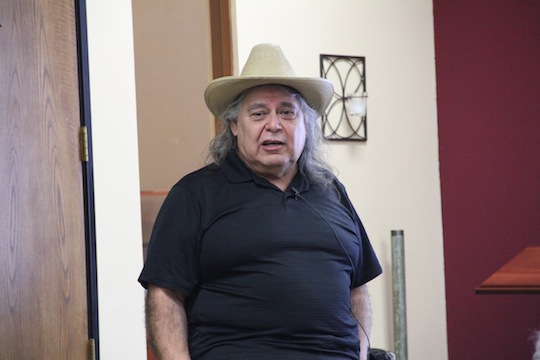
Dr. Paul Apodaca Discusses Folklore & Mythology at the Chapman Visiting Scholars Series
On Saturday, February 16, Dr. Paul Apodaca met with nearly 30 Nicholas Academic Centers’ students for the latest installment of the Chapman Visiting Scholars Series, this time focusing on folklore & mythology of the peoples of North America.
To open the lecture, Dr. Apodaca discussed how the study of folklore and folk culture differs from Anthropology, Sociology, Psychology, or other disciplines, including economics. Dr. Apodaca maintains that while a psychologist might interpret certain actions and behaviors as manifestations of unspoken motivation, such as recognizing eating as an expression of anger, folklore appreciates nature and humanity in a more straightforward manner.
“The thing that I like about folklore is that it doesn’t change what we’re doing. It says you’re doing what you say you’re doing, and we’re just happy you value it.” He continues, “We accept the culture as it says it is, and for that reason, I think folklore studies, especially, is very good for American Indians and a lot of other cultures because people end up feeling like they are still themselves. It’s kind of funny to do what you think is normal to you, what you think is fun, and have someone tell you it has all these complex meanings to it that you didn’t realize.”
Although he shared many myths & fables during the lecture, such as the creation of men and women, Dr. Apodaca gave special attention to a story associated with an iconic image of Popocatepetl and Iztaccihuatl, and explained how several stories relate to the history and geography of a people. According to Dr. Apodaca, “Indians take the landscape around them and then put stories into the landscape,” thus transforming the world into a global library. Dr. Apodaca contends that integrating stories and landscapes reminds people what is important to them.
NAC student Javier Armenta, a sophomore at Valley High School, agrees. “The most interesting part was learning that everything has a story behind it; everything in nature has a story behind it.”
For the second half of the lecture, Dr. Apodaca turned his attention to symbolism as used in the arts and crafts of the peoples of North America, and he challenged students to think differently, to find meaning in symbols rather than rely on linear thinking and literal representation.
“Once you understand [how symbols are used in Southwestern art], you’ll be able to look at ceramics, cloth, or anything in the culture, and see how things work together through symbolism.” Dr. Apodaca claims that all Southwestern art symbolizes life as coming from two sources: rain and corn. “The two most important things in a desert culture are rain and corn; if you’ve got rain, then you’ve got corn, and that means you live.” Artists use basic shapes like circles, squares, and triangles to symbolize rain, clouds, mountains, and even animals, like rain birds. Southwestern art also maximizes the use of both positive and negative space.
NAC student, Luis Campos, a junior at Santa Ana High School, appreciated the study of symbols. “In today’s lecture, I [enjoyed] the second part, about how the shapes [painted on Southwestern ceramics] describe lightning, water, and mountains, and I loved the [rain] bird, pretty much; it’s just creative art.”
The next Chapman Visiting Scholars Series lecture will take place on Saturday, March 16, at the NAC Annex. As always, lunch will be served.
(Click HERE to watch a video of the event on our Youtube channel.)
